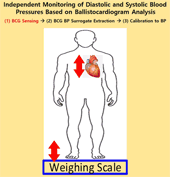
The goal of this study was to propose and establish the proof-of-concept of an ultra-convenient cuffless blood pressure (BP) monitoring approach based on the ballistocardiogram (BCG). The proposed approach monitors systolic and diastolic BP (SP and DP) independently by exploiting two mechanistically derived features in the whole-body, head-to-foot BCG measured using a force plate: the time interval between the first (“I”) and second (“J”) major waves (“I-J interval”) for DP, and the amplitude between the J and third major (“K”) waves (“J-K amplitude”) for pulse BP (PP; which can be added to DP to yield SP). The efficacy of the approach was examined in 22 young healthy volunteers, by investigating the DP monitoring performance of pulse transit time (constructed as the time interval between the BCG I wave and the diastolic minimum of foot volume pulse), pulse arrival time (constructed as the time interval between the ECG R wave and the diastolic minimum of finger volume pulse), and the BCG’s I-J interval, and the SP monitoring performance of pulse transit time and I-J interval in conjunction with the BCG’s J-K amplitude. The BCG’s I-J interval was comparable to pulse transit time and pulse arrival time in monitoring DP, and the BCG’s J-K amplitude could provide meaningful improvement to pulse transit time and I-J interval in monitoring SP. Hence, we concluded that the BCG may contribute toward ultra-convenient and more accurate cuffless BP monitoring. The significance of the proposed approach is that it has potential to complement the conventional pulse transit time technique for cuffless BP monitoring in two ways. First, it may be integrated with pulse transit time to enable independent monitoring of DP and SP. Second, it may even enable DP and SP monitoring from the BCG alone.

